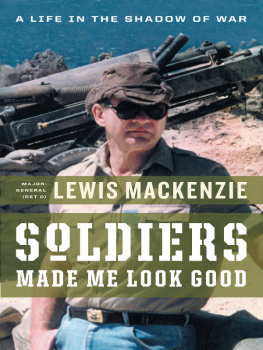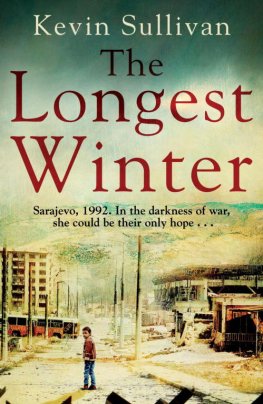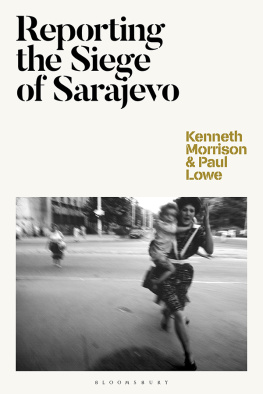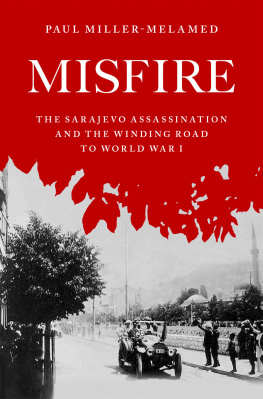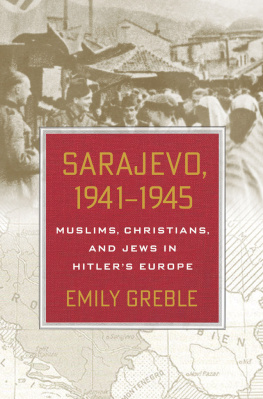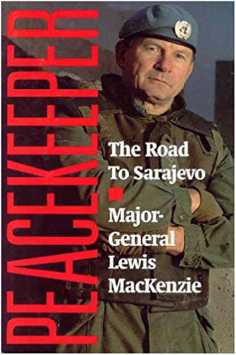


PEACEKEEPER
The Road to Sarajevo
Lewis MacKenzie
Douglas & McIntyre V ancouver/T oronto
Copyright 1993 by Lewis MacKenzie
93 94 95 96 97 5 4 3 2 1
All rights reserved. No part of this book may be reproduced or transmitted in any form or by any means without permission in writing from the publisher, who may quote brief passages in a review.
Douglas & McIntyre
1615 Venables Street
Vancouver, British Columbia
VjL 2HI
Canadian Cataloguing in Publication Data
MacKenzie, Lewis, 1940-
Peacekeeper
isbn 1-55054-098-x
1. United NationsArmed ForcesYugoslavia.
2. YugoslaviaHistoryCivil War, 1991-
3. MacKenzie, Lewis, 1940- I. Title.
JX1981.P7M23 1993 355-3'57'09497 C93-091596-8
Editing by Roy MacSkimming
Jacket design by Rick Staehling
Front cover photo by Peter Bregg/ Maclean's
Back cover photo by Sgt. Christian Coulombe/Department of National Defence
Text design by Tom Brown
Maps by William R. Constable
Typesetting by Vancouver Desktop Publishing Centre
Printed and bound in Canada by D. W. Friesen & Sons Ltd.
Printed on acid-free paper o
This book is dedicated to my wife, Dora, and daughter, Kimm, who for many years gracefully tolerated my long and frequent absences on peacekeeping tours of duty; and to each and every soldier who has served with me, particularly the magnificent international group in Sarajevo, dominated by the contingents from Canada and France.
Bless them all.
Contents
ACKNOWLEDGEMENTS IX
LIST OF MAPS XI
INTRODUCTION XIII
1 | A CALL FROM HOME
2 | GETTING INTO PEACEKEEPING THE HARD WAY
3 | TAN-LESS IN GAZA 14
4 | CYPRUS FIRST TOUR 27
5 | CYPRUS SECOND TOUR 42
6 | SLUMMING IN SAIGON 49
7 | BACK IN THE MIDDLE EAST
8 | CYPRUS THIRD TOUR 72
9 | OBSERVING IN CENTRAL AMERICA
10 | RUMOURS OF YUGOSLAVIA 93
11 | NEW YORK, NEW YORK 99
12 | ON THE GROUND
13 | GETTING TO KNOW SARAJEVO 14 | PRELUDE TO WAR
15 | ANARCHY TAKES OVER
16 | DAMNED IF WE DO...
17 | THE CONVOY INCIDENT
18 | QUICKSAND, BALKAN-STYLE I78
19 | BACK TO BELGRADE
20 | TALKING MY WAY INTO COMMAND
21 | THE ROAD TO SARAJEVO
22 | END OF A CEASEFIRE
23 | FROM PEACEKEEPER TO WAR CRIMINAL
24 | PRESIDENT MITTERAND DROPS IN
25 | A UN AIRPORT
26 | THE CANADIANS ARE COMING
27 | THE HARDEST DECISION OF MY CAREER
28 | GOODBYE TO SARAJEVO
29 | THE AFTERMATH 324
30 | WHITHER UN PEACEKEEPING?
index
Acknowledgements
thanks to: General Satish Nambiar, for being such an outstanding boss; Cedric Thornberry for his sage advice; General Philippe Morillon for his friendship and example; Major Steve Gagnon for being the best assistant any general ever had; Warrant Officer Traclet and Corporal Leroux for keeping me sane; Colonel Vitali Petrounev for showing me how stupid Id been to dislike Russians for the first fifty years of my life; Colonel Svend Harders for his magnificent support and cigarettes; Roy MacSkimming for his help and advice and for correcting my grammar; Linda McKnight for introducing me to the book business; Gerald Clark for introducing me to Linda; Doreen Potter for converting my pencilled scribbling into a legible manuscript; Martin Bell for unwittingly launching the idea for this book; and Scott McIntyre for believing I could write.
L.M.
List of Maps
SARAJEVO AND ENVIRONS, 1992 ENDPAPERS
UNITED NATIONS OBSERVER GROUP
Introduction
in june 1992, when I was chief of staff with the United Nations Protection Force (unprofor) in the former Yugoslavia, correspondent Martin Bell of the British Broadcasting Corporation was interviewing me in my office in Sarajevo. Martins cameraman panned to a shot of my chronically cluttered desk. Sitting to the side of the desk was my brown, plastic-covered, one-year diary that I had bought for $4.29 back home, to record my hotel and meal expenses in a fashion that would satisfy the UN bureaucracy. Later that night, unbeknownst to me, Martins commentary during his televised report referred to the red, leather-bound diary on General MacKenzies desk that will probably be a book someday.
Within weeks, I had received queries from a number of major publishing houses, all wanting to discuss the rights to my diary. One thing led to another, and this book was born.
Writing a book about my life in uniform was something Id considered since I was a young officer. Military life is characterized by so many memorable and frequently humorous events that I thought a memoir would make interesting reading, and writing it would be good therapy in my waning years. But when the time came to sign a publishing contract, much sooner than Id expected, I hoped that a ghost writer would assume the challenge of turning my rambling reminiscences into a coherent record of my career as a soldier and sometime peacekeeper.
No such luck. Unfortunately, my publisher and new friend, Scott McIntyre, decided that the book should be written in my own words. Scott set me to work, and a concerted effort between Christmas 1992 and May 1993 produced what is contained between these covers.
The early chapters about my previous peacekeeping experiences were fun to write, because they reminded me of many old friends and incidents that had lain dormant in my memory for years. On several occasions, my wife, Dora, opened the door to my study and asked me what I was laughing about. With tears of nostalgia and joy, I would describe to her one of the more memorable moments of my life.
Lest the reader think that un peacekeeping is all fun and games, however, please understand that I kept no records during my first eight peacekeeping tours, between 1963 and 1991 (actually seven, but Gaza was a double, two-year tour). If you try to remember what you did thirty years ago, the chances are pretty good that, like me, you will remember mainly the good times and the tragedies. The run-of-the-mill events and daily routines probably dont warrant description anyway. On the other hand, the pranks and disasters, the times when you were really scared, stand out as if theyd happened yesterday. They are the memories Ive included here, and they are also the ones that inundated me with waves of nostalgia and feeling when I recorded them.
Until the Yugoslavian conflict erupted in 1991, United Nations peacekeeping, with a few notable exceptions, was pretty straightforward. Two or more countries, or warring factions within a country, decided they wanted to stop fighting and turned to the UN for help. A ceasefire was arranged, after which a multinational force of peacekeepers arrived with their white vehicles and blue berets and placed themselves in a demilitarized zone between the parties. The peacekeepers quickly established mechanisms to keep the peace: everything from telephone hot lines between the sides to regular conferences and meetingsin fact, anything at all that would keep the dialogue going between the combatants. The UN strategy was simple but pragmatic: if the fighting was to be kept under control, the best way was to keep talking. Thats why I became so frustrated in Sarajevo when I couldnt convince the Bosnian President, Mr. Alija Izetbegovic, to talk directly with Dr. Radovan Karadzic, the leader of the Bosnian Serbs.
Next page

